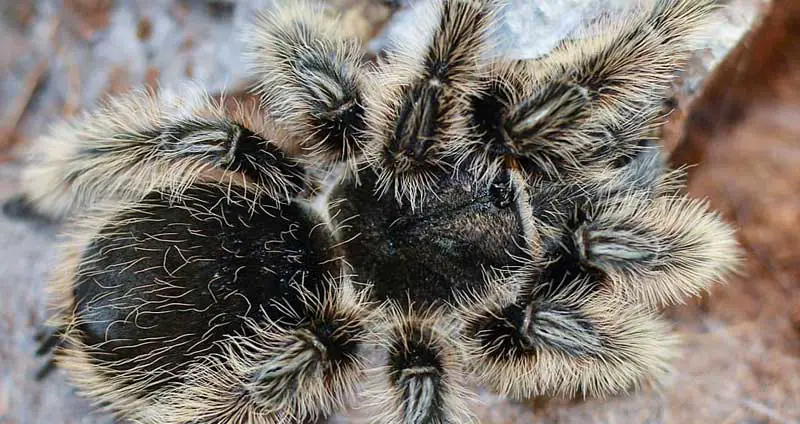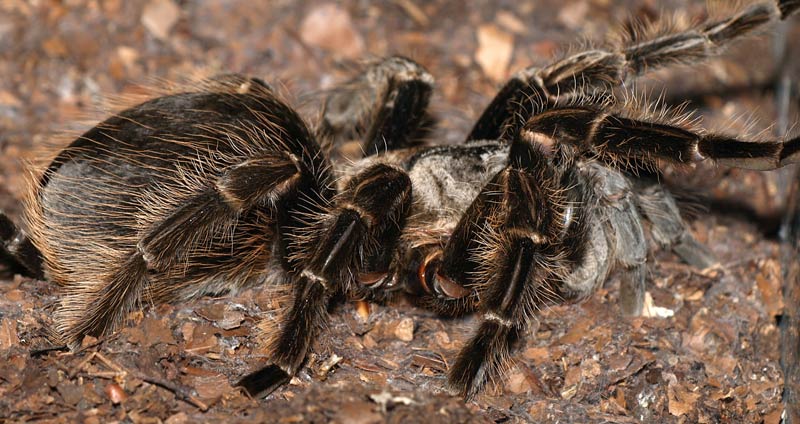Some tarantulas are popular among beginners, while others are limited only to hardcore enthusiasts. However, there’s also some species that are enjoyed by everybody due to their all-around great appearance and temperament. Brachypelma albopilosum, or the Honduran Curly Hair tarantula, is one of those species.
This guide will tell you all that you need to know about this fascinating tarantula species in terms of what to expect and how to care for them properly.
Table of Contents
Brachypelma albopilosum Care Sheet
| | |
Common Name |
Honduran Curly Hair |
Species Type |
New world terrestrial |
Natural Habitat |
Found in the savannas of Central America. Very average climate with decent humidity and higher year-round temperatures. They spend most of their time on the ground and occasionally burrow. |
Growth Rate |
Medium growth rate, taking a few years to reach full size. However, it is one of the faster-growing species in the genus. |
Adult Size |
Females reach a legspan of about 6″, while males are a bit smaller. |
Lifespan |
Females live for around 10 years, while males only live about 4. |
Enclosure |
The enclosure needs plenty of floor space for the tarantula to walk around. Several inches of substrate need to be present for burrowing. Additionally a water dish and sizable hide should be provided. |
Temp/Humidity |
75°F to 80°F with about 65% to 70% humidity. |
Diet |
Great eater that can eat an adult cricket every day when fully-grown. |
Temperament |
Very docile. Almost never throws up a threat pose or kicks hairs. |
Experience Level |
Beginner – A very hardy tarantula that’s easy to care for and not dangerous at all to be around. |
Average Cost |
Slings ~ $30, Males ~ $50, Females ~ $100+ |
Brachypelma albopilosum Appearance
One of the main reasons why this tarantula is so popular is because of its great appearance! Some people want tarantulas because they’re scary or intimidating, while others aim for “cute”. This tarantula is definitely cute.
B. albopilosum is quite a heavy-bodied tarantula that’s covered in dark/brown hairs as a base, while tan and gold hairs that are characteristically curly sprout up all over, giving it a fluffy and, frankly, adorable appearance. This approachable tarantula has brought many tarantula owners into the hobby and made it a favorite.
This tarantula has a fairly average growth rate, reaching its maximum legspan from its spiderling stage in a couple of years. However, it is quite fast compared to other tarantulas in the genus, making it more attractive for beginners as there’s a quicker payoff.
While they are cute, females are able to reach 6″ in legspan, which is certainly not small. Overall, while its coloration isn’t as crazy as, say, Chromatopelma cyaneopubescens, it’s a very attractive tarantula that catches the eyes of beginner and experienced keepers alike.


via @_daniel138_ / Instagram
Brachypelma albopilosum Temperament
While the appearance is great, its the temperament of this tarantula that really solidifies it as a great addition to any collection. The Avicularia genus is known as the genus for beginner-friendly tarantulas, but Brachypelma albopilosum gives them a run for their money.
To begin with, this is a new world tarantula, meaning that it’s very laid-back, friendly, and prefers to run away instead of fighting a potential threat. This essentially means that new world tarantulas are easier to care for and are highly recommended for beginners or keepers that don’t want to deal with dangerous species.
B. albopilosum is no exception to the new world tarantula stereotype. It’s exceptionally laid-back and owners report virtually never seeing them throw up a threat pose or flick urticating hairs. Many owners hold this tarantula frequently without issues, but we can’t recommend that you handle any tarantula.
While it’s a docile species, that doesn’t mean that it doesn’t have spunk. In fact, the Honduran Curly Hair is said to be one of the most active tarantulas, making it a lot of fun to observe. It moves about its enclosure frequently, stays quite visible, and even rearranges its enclosure regularly.
Housing Brachypelma albopilosum
Whenever you bring a new tarantula home, you need to make sure that it is given the best enclosure possible from day one. This will help to keep your tarantula happy, healthy, and content — all things that increase its quality of life.
This particular species is from Central America — specifically Costa Rica, Honduras, and Nicaragua. In this habitat, they experience quite an average climate with temperatures year-round between 70°F and 90°F and humidity levels around 60-70%.
These are very moderate conditions, meaning that they won’t require a lot of special care when it comes to the climate of their enclosure.
Optimal Enclosure
It’s quite easy to provide this tarantula with an optimal enclosure. It does have specific environmental needs, but they aren’t hard to meet. First of all, this is a terrestrial tarantula, meaning that it spends all of its time on the ground.
Because of this, Brachypelma albopilosum requires a typical terrestrial tarantula enclosure — an enclosure that’s longer and wider than it is tall. Copious amounts of floor space is a must!
The Exo Terra 18″x18″x12″ glass terrarium provides this tarantula with plenty of room to create webbing, rearrange its enclosure, and create burrows to hide out in. It’s also exceptionally accessible and provides great visibility.
Inside of the enclosure, you’ll want to provide your tarantula with several inches of moisture-retaining substrate, a sizable hide, a water dish, and a couple of rocks and fake plants. There aren’t a lot of essential supplies that your tarantula needs, so don’t skimp out when creating their enclosure.
Diet
While this may not be the biggest tarantula out there, it’s certainly one of the best eaters! Owners state that this is one of their most ravenous tarantulas, attacking its prey quickly and efficiently subduing it. For people that are looking for an entertaining tarantula, this is a great trait!
Spiderlings are given flightless fruit flies due to their very small size. As they age, though, food can become larger. Adults are typically given an adult cricket every single day, or two adult dubia roaches per week.
Health Issues
This tarantula species is particularly hardy — another great trait for beginners! Brachypelma albopilosum can thrive in a ride spectrum of different temperatures and humidities. It’s also not predisposed to any health issues. The main issues that you could possibly run into are dehydration and parasites/mites. Both of these are easy to prevent and deal with.
While it’s rare, it’s possible that your tarantula may experience problems with its molt. A stuck molt can be a death sentence for a tarantula, so you’ll need to intervene in this case. Fortunately, it’s quite easy to help a tarantula due to the copious amounts of helpful guides online.
Brachypelma albopilosum For Sale
If you want to purchase one of these tarantulas for yourself, you should have a decently easy time acquiring one! Popular tarantulas like Avicularia avicularia tend to be quite cheap and accessible because everybody wants one and they’re relatively common.
You can find Brachypelma albopilosum on sale in many different online marketplaces. Spiderlings, unsexed juveniles, and sexed adults are all available for decent prices. Slings tend to sell for around $30, unsexed juveniles are about $50, and sexed adults are about $75 for males and $100 for females. Prices do vary widely, but they’re typically all around that range.
So, if you’re looking for an excellent tarantula that has a unique appearance, easy-going and interesting personality, and easy care requirements, look no further than Brachypelma albopilosum. It’s affordable, agreeable, and a great addition to any tarantula collection.

